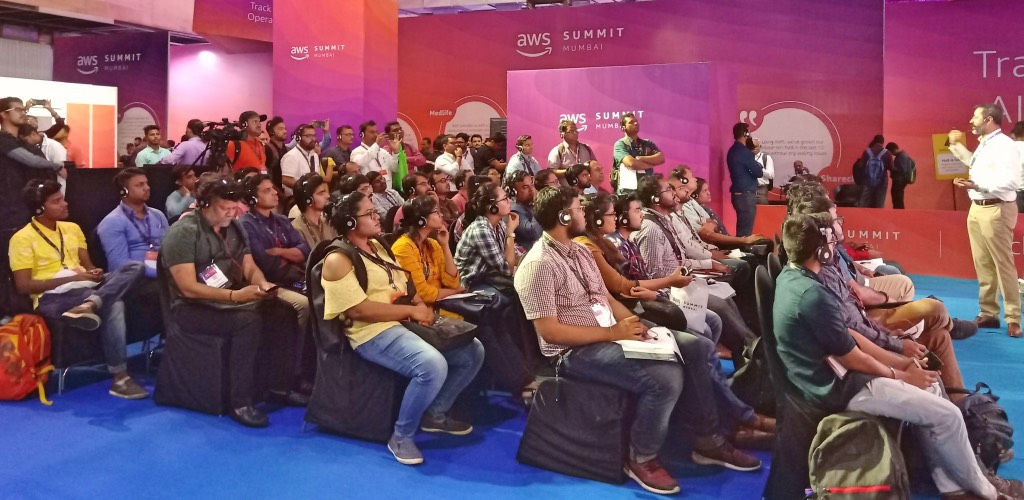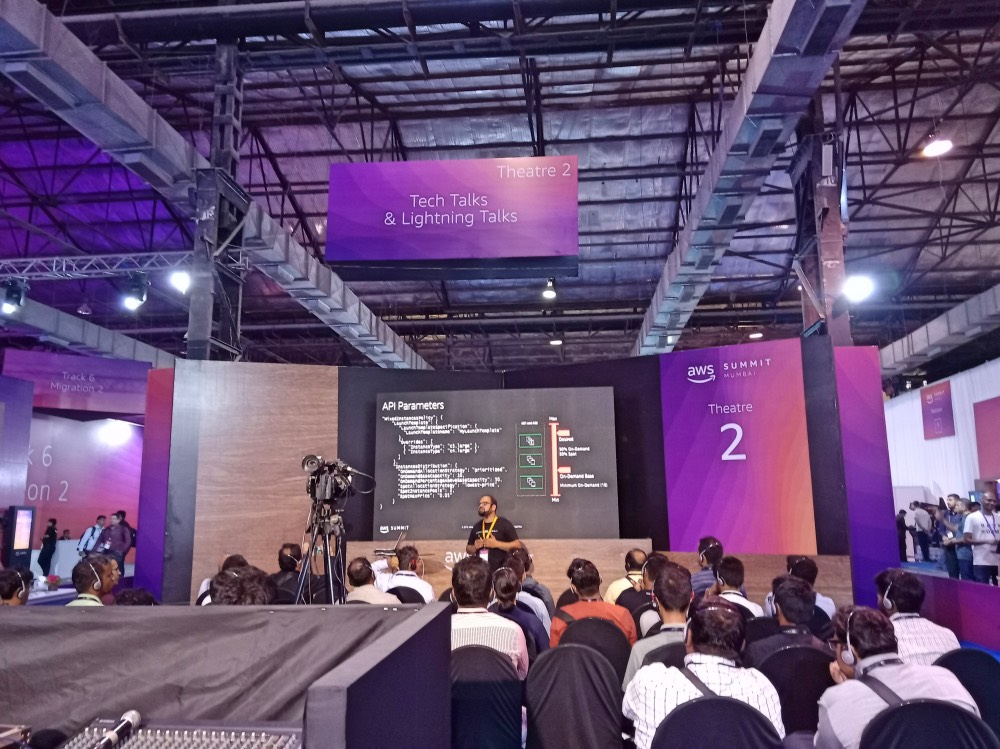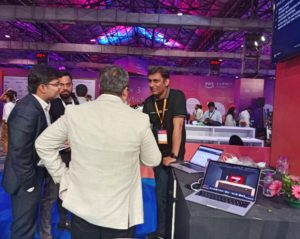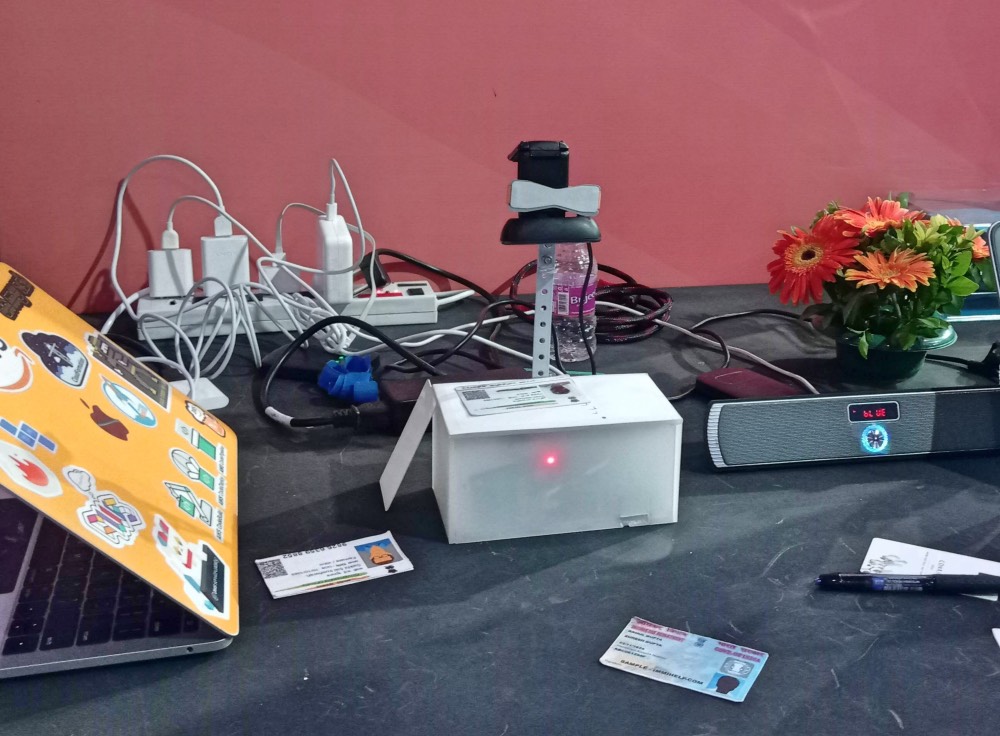Every year, in the month of May, a swarm of developers converges at the Bombay Exhibition Centre (BEC) to get their knowledge updates, product information, training, and certifications from Amazon Web Services (AWS). The AWS Summit is growing 40% year-on-year, and it’s hailed as the “largest IT user event in India”. This year close to 7,000 people attended over three days, with some part of the event held in a city 5-star hotel. The rising numbers and the familiar brands of AWS customers that flash across the screens send out a clear message: almost every enterprise, start-up, and public sector company wants to be included in the AWS universe.
This year’s event in Mumbai (13 – 15 May) had 110 content sessions and 40 breakout sessions across 8 tracks. There was an exhibition, and specialized training zones such as Start-up Central, Tech Talks, Lightning Talks, AWS Workshops, AWS Zone, and Certification Lounge. There were two industry tracks dedicated to FSI and Media & Entertainment. In addition, the program included an AWS Women in Tech day.

IMAGE CREDIT: DIGITAL CREED
So, who are all these people coming to the AWS Summit every year? We are told they are enterprise customers, start-ups, SMBs, builders (developers), ISVs, and system integrators. And of course, various teams from AWS itself. They line up patiently to collect their headsets (and goodie bags); they listen attentively during the training; and they don’t mind squatting on the carpeted floors during the breaks to catch up on work, peering into their sticker infested laptops.
This fast expanding universe of AWS user groups and “community heroes” is enormous: 32,170 members across 17 user groups in 12 cities. AWS has trained 260,000 people to date and certified 75,000 developers.

IMAGE CREDIT: DIGITAL CREED
Customers Embrace Cloud for Innovation
Millions of active customers are using some of AWS’s 165 services each month in over 190 countries around the world, including hundreds of thousands of active customers in India. Organizations are moving their mission-critical workloads to the AWS cloud to drive cost savings, accelerate innovation, and speed time-to-market. According to AWS, Indian customers are scaling rapidly, and transforming the services they provide to their customers.
AWS customers include: Ashok Leyland, ABP News Network, ArisGlobal, Bajaj Capital, Bombay Stock Exchange, Capital Float, Clevertap, Future Group, Hindustan Unilever Limited, Hotstar, India Today, LimeRoad, MedLife, MakeMyTrip, Nazara, Practo, PolicyBazaar.com, RazorPay, redBus, Shaadi.com, ShareChat, Tata Sky, Wynk, Zeta, and many more.
These customers have either migrated their previous applications from on-premise infrastructure to the cloud or are developing new cloud-native applications. They are using AWS services and paying as they consume instead of buying and deploying their own infrastructure.
Take the example of Ashok Leyland, the fourth largest bus manufacturer in the world with $4.02 billion in annual revenue. It has moved its infrastructure from another cloud to the AWS platform. Speaking at the AWS Summit, Venkatesh Natarajan, Chief Digital Officer and Senior Vice President – IT, Ashok Leyland said changing customer demands are driving innovation at the company.
Automobile manufacturers like Ashok Leyland are transforming to become much more than OEMs who offer customers products through retail outlets – or communicate with customers via retail outlets. Ashok Leyland is repositioning itself as a provider of connected mobility solutions – with direct contact between the OEM and the customer. It is banking on AWS services and the AWS platform to deliver these new solutions to its customers.
Three years ago, Ashok Leyland launched the Digital Market place that addresses four key trends in the automobile industry: Autonomous, Connected, Electric, Shared. Natarajan thinks the new solutions his company is providing will provide significant revenues (40% of total revenue) in 5 years. The rest will come from services, spares, and products. Moreover, technology and data will be the “backbone” for providing solutions. He has embraced digital for cost optimization, business optimization, and new business models or revenues.

IMAGE CREDIT: DIGITAL CREED
Amazon Partner Network
The Amazon Partner Network (APN) is also critical to AWS’ success. The APN includes tens of thousands of independent software vendors (ISVs) and systems integrators (SIs) around the world, with APN Partner participation in India growing significantly since the AWS Region opened in 2016. APN Partners build innovative solutions and services on AWS, and the APN network provides partners with business, technical, marketing, and go-to-market support.
If you look at the demand-supply chain, you’ll see that developers create applications that fuel the innovation that companies want. Hence start-ups and enterprises want to hire builders with new skills in machine learning, artificial intelligence, IoT, blockchain, VR/AR. AWS offers services for all this on their platform, but somebody must build the applications. There aren’t enough builders with these cutting-edge skills to meet this massive demand from enterprises. Hence, AWS is attempting to train developers in these new skills and is offering certification. AWS is also offering tools like SageMaker to help companies accelerate their journey to machine learning – because many data scientists and engineers are yet to acquire machine learning skills.
Third Availability Zone
The AWS customer network in India is proliferating so rapidly that the company just announced the opening of its third Availability Zone in the AWS Asia Pacific (Mumbai) Region.
AWS Regions are comprised of Availability Zones, which refer to technology infrastructure located in separate and distinct geographic locations with enough distance between them to significantly reduce the risk of a single event impacting availability, yet near enough for business continuity applications that require rapid failover. Each Availability Zone has independent power, cooling, physical security, and is connected via redundant, ultra-low-latency networks.

IMAGE CREDIT: DIGITAL CREED
Builder’s Fair
The AWS Summit included an exclusive zone called the Builder’s Fair with demos of applications that could potentially be rolled out as business applications across industries. The AWS in-house builders are developing these Proof of Concept (PoC) applications. Solution architects from AWS, ISVs, and system integrators could take these PoCs forward and create business applications if an organisation wants to use these applications.
The PoCs use all the AWS building blocks (AWS services) for innovative applications.
Some of the demos we witnessed at the Builder’s Fair include:
- Smart Car Parking
- Security Automation toolkit
- Intelligent Car Damage Accessor (for auto insurance)
- Omni-channel contact center
- Digital Dermatology
- Virtual Personal Banking Assistant
- Keyboardless KYC
Reporting and images: BRIAN PEREIRA

IMAGE CREDIT: DIGITAL CREED









